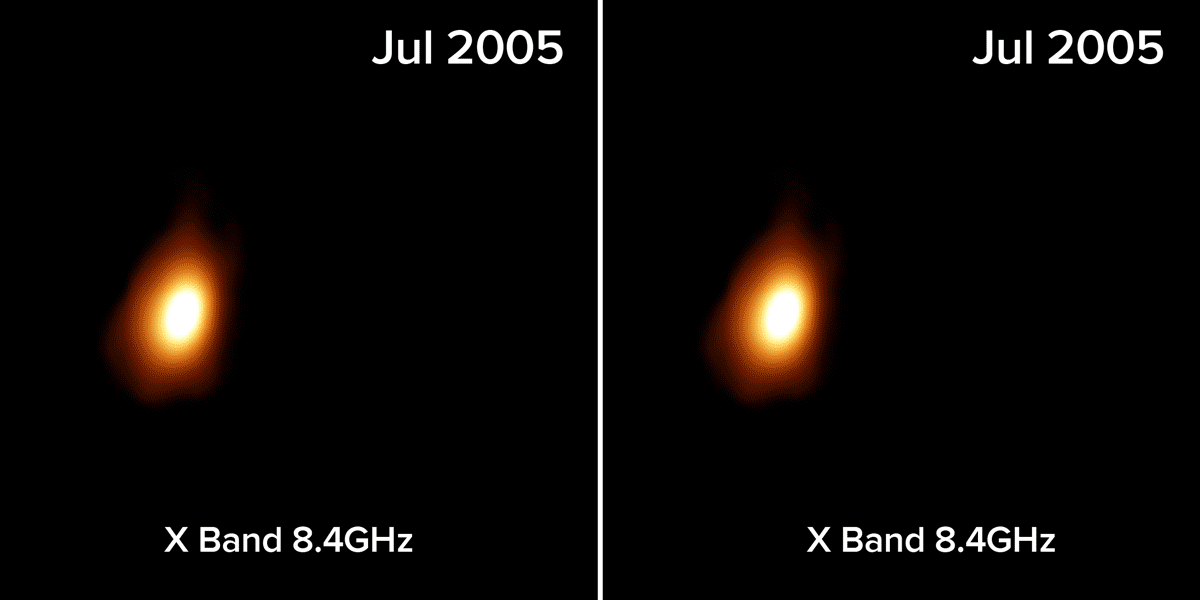
Thirteen years ago, two supernova-hunting teams were surveying colliding galaxy pair Arp 299—one looking for radio waves, one for infrared emissions. Instead of an exploding star, energetic infrared signals pointed to something even weirder.
Now, the researchers have pieced together a violent explanation: a bright jet of hot matter spurting from a dying star as it's pulled apart by the gravity of a hungry supermassive black hole. The team reported its findings Thursday in the journal Science.
Scientists call these brutal dances tidal disruption events (TDEs), few of which have ever been detected. In fact, this is the first time astronomers have directly observed one of their jets. "We directly imaged the formation of a fast-moving [jet] of material erupted by the black hole as it ripped apart the star," study author Miguel Pérez-Torres of the Astrophysical Institute of Andalusia in Granada, Spain, told Newsweek. The material in the jet, he added, was moving at a quarter of the speed of light for the duration of their observations.
In a TDE, a black hole guzzles about half a star's mass into an orbiting accretion disk. The black hole tugs on the star just like the sun and moon's gravitational forces tug on the tides of Earth. The resulting stellar disk churns out X-rays and visible light alongside a powerful jet of material that shoots from its poles. The other half of the star's mass is flung from the system.
The team used radio and infrared telescopes to track this particular star's final ferocious moments in fine detail over the course of a decade.
It was the use of both radio and infrared telescopes that allowed them to conclude they had witnessed a TDE. Astronomers needed the radio observations to conclude they'd seen a TDE, but these observations weren't enough to spot the energetics in the first place, study author Seppo Mattila of the University of Turku in Finland explained to Newsweek. "It is the infrared and radio observations together that allowed us to confidently draw conclusions on the nature of this event," he explained.
The conclusion, however, is not without controversy. Other TDEs have been classified as such from observations based on visible light, but a shroud of dust made that impossible this time around.

Praising the "excellent" study, astronomer Erin Kara from the University of Maryland said the team's TDE identification was reasonable. But, she cautioned the layer of dust made it hard to say for sure. "Unfortunately because this is a highly obscured system, you can't really see any direct emission from the innermost region around the black hole," she told Newsweek. "Thus it is difficult to definitely say that it is a TDE and not just normal variability typical of a [persistently accreting black hole]."
What's certain is this research opens up new possibilities for scouting other hidden zones. "We may be missing a lot of TDEs that are enshrouded in gas and dust, especially if [they] occur preferentially in merging galaxies (where the black hole is often obscured)," Kara added. "Searching for infrared dust echoes may be a really successful way to find new TDEs."
"Future infrared missions may allow us to detect many more TDEs, which have been currently hidden by a curtain of dust," Mattila said. New and improved radio telescopes will also help astronomers pinpoint more of these incredible events, he added.
"What I love about this result is that it was serendipitous, as many of the most exciting astronomical results are," Kara said. "In these initial observations of this merging galaxy, they were not looking for activity around the supermassive black hole, but that is what they found."
Uncommon Knowledge
Newsweek is committed to challenging conventional wisdom and finding connections in the search for common ground.
Newsweek is committed to challenging conventional wisdom and finding connections in the search for common ground.
About the writer
Katherine Hignett is a reporter based in London. She currently covers current affairs, health and science. Prior to joining Newsweek ... Read more
To read how Newsweek uses AI as a newsroom tool, Click here.








